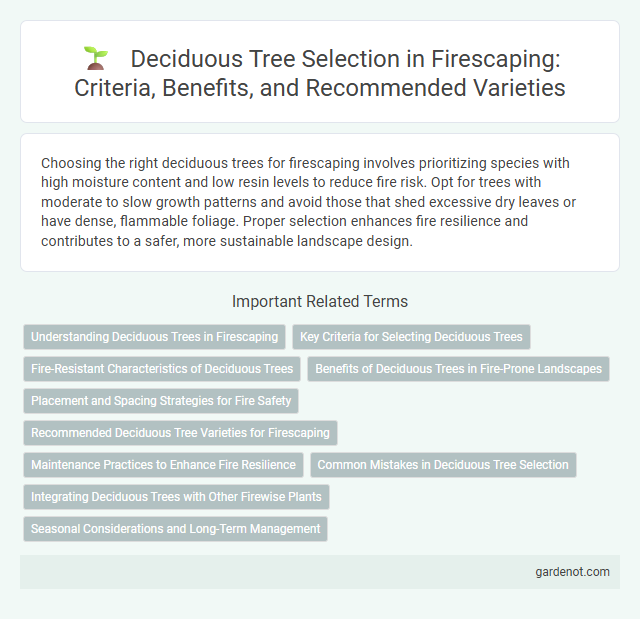Choosing the right deciduous trees for firescaping involves prioritizing species with high moisture content and low resin levels to reduce fire risk. Opt for trees with moderate to slow growth patterns and avoid those that shed excessive dry leaves or have dense, flammable foliage. Proper selection enhances fire resilience and contributes to a safer, more sustainable landscape design.
Understanding Deciduous Trees in Firescaping
Deciduous tree selection in firescaping requires understanding species with high moisture content and low resin levels to reduce flammability. Choosing trees like maples or oaks helps create effective fuel breaks due to their dense, broad leaves that retain moisture during fire-prone seasons. Proper spacing and maintenance of deciduous trees enhance safety by limiting ladder fuels and minimizing fire spread.
Key Criteria for Selecting Deciduous Trees
Key criteria for selecting deciduous trees in firescaping include drought tolerance, low resin content, and fire-resistant bark to minimize flammability. Choosing species with broad, high-moisture leaves and moderate canopy density reduces fire intensity and helps create effective defensible space. Proper placement considering wind patterns and proximity to structures further enhances fire safety and landscape resilience.
Fire-Resistant Characteristics of Deciduous Trees
Deciduous trees with fire-resistant characteristics typically have thick, moist bark and a high moisture content in leaves, reducing flammability and heat transfer. Species like oak, maple, and birch demonstrate high resistance due to their dense wood and minimal resin content, which prevents rapid ignition. Selecting these fire-adapted deciduous species enhances landscape resilience in fire-prone areas by slowing fire spread and protecting surrounding vegetation.
Benefits of Deciduous Trees in Fire-Prone Landscapes
Deciduous trees offer fire-prone landscapes significant benefits by reducing fire intensity through their seasonal leaf drop, which decreases available fuel during critical fire seasons. Their higher moisture content and broad leaves contribute to lower flammability compared to evergreen species, enhancing landscape resilience. Selecting deciduous trees such as oaks, maples, and aspens supports effective fire management while maintaining ecosystem health and biodiversity.
Placement and Spacing Strategies for Fire Safety
Selecting deciduous trees for firescaping requires careful placement and spacing to reduce fire risk by creating defensible space. Position trees at least 10 to 15 feet apart and maintain a minimum of 10 feet from structures to prevent fire spread through canopy contact. Incorporating species with lower resin content and regularly pruning lower branches further enhances fire resilience within the landscape.
Recommended Deciduous Tree Varieties for Firescaping
Recommended deciduous tree varieties for firescaping include species with high moisture content, low resin production, and minimal litter accumulation such as Ginkgo biloba, Liquidambar styraciflua (Sweetgum), and Acer rubrum (Red Maple). These trees enhance fire resistance by maintaining lush foliage during fire-prone seasons and reducing flammable debris on the ground. Selecting deciduous trees like Betula nigra (River Birch) also contributes to effective defensible space in wildfire mitigation strategies.
Maintenance Practices to Enhance Fire Resilience
Selecting deciduous trees with fire-resilient species such as oaks, maples, and ashes supports effective firescaping strategies. Regular maintenance practices including proper pruning to remove dead branches, clearing leaf litter, and maintaining adequate spacing reduce fuel load and improve tree health. Implementing consistent irrigation and monitoring for pest damage further strengthens tree resilience against fire.
Common Mistakes in Deciduous Tree Selection
Choosing deciduous trees without considering their fire resistance can increase wildfire risks in firescaping efforts. Common mistakes include selecting species with highly flammable leaves or bark and ignoring proper spacing to prevent fire spread. Prioritizing native, fire-resistant deciduous trees like oak or maple enhances landscape safety and resilience.
Integrating Deciduous Trees with Other Firewise Plants
Strategically selecting deciduous trees for firescaping involves prioritizing species with high moisture content and low resin levels, such as maples, oaks, and birches, to reduce flammability. Integrating these trees with fire-resistant shrubs like manzanita and ceanothus creates layered vegetation that acts as a natural firebreak, disrupting fire spread. Proper spacing between deciduous trees and firewise plants enhances airflow and minimizes fuel continuity, crucial for effective fire mitigation in wildfire-prone landscapes.
Seasonal Considerations and Long-Term Management
Selecting deciduous trees for firescaping requires attention to seasonal changes, as these trees shed leaves in fall, reducing combustible material near structures. Choosing species with high moisture content and low resin levels in leaves enhances fire resistance throughout spring and summer. Long-term management involves regular pruning and clearing of fallen leaves to minimize fuel accumulation and maintain defensible space around properties.
Deciduous tree selection Infographic

 gardenot.com
gardenot.com